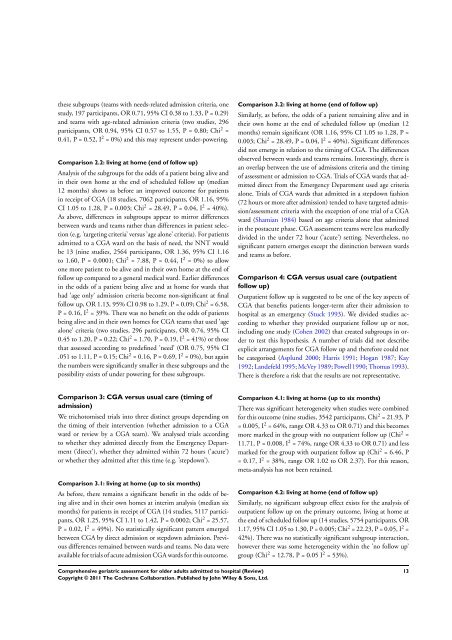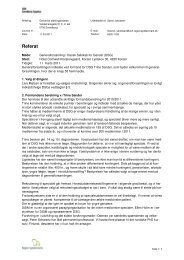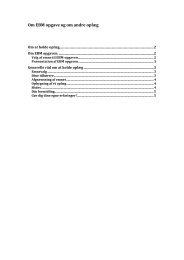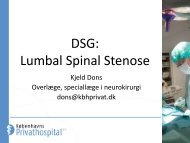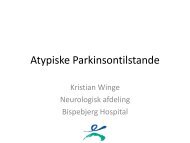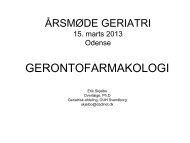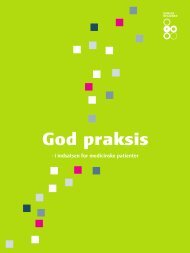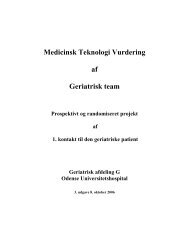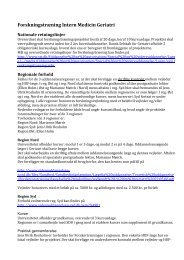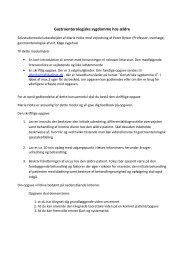Comprehensive geriatric assessment for older adults admitted to ...
Comprehensive geriatric assessment for older adults admitted to ...
Comprehensive geriatric assessment for older adults admitted to ...
Create successful ePaper yourself
Turn your PDF publications into a flip-book with our unique Google optimized e-Paper software.
these subgroups (teams with needs-related admission criteria, one<br />
study, 197 participants, OR 0.71, 95% CI 0.38 <strong>to</strong> 1.33, P = 0.29)<br />
and teams with age-related admission criteria (two studies, 296<br />
participants, OR 0.94, 95% CI 0.57 <strong>to</strong> 1.55, P = 0.80; Chi 2 =<br />
0.41, P = 0.52, I 2 = 0%) and this may represent under-powering.<br />
Comparison 2.2: living at home (end of follow up)<br />
Analysis of the subgroups <strong>for</strong> the odds of a patient being alive and<br />
in their own home at the end of scheduled follow up (median<br />
12 months) shows as be<strong>for</strong>e an improved outcome <strong>for</strong> patients<br />
in receipt of CGA (18 studies, 7062 participants, OR 1.16, 95%<br />
CI 1.05 <strong>to</strong> 1.28, P = 0.003; Chi 2 = 28.49, P = 0.04, I 2 = 40%).<br />
As above, differences in subgroups appear <strong>to</strong> mirror differences<br />
between wards and teams rather than differences in patient selection<br />
(e.g. ’targeting criteria’ versus ’age alone’ criteria). For patients<br />
<strong>admitted</strong> <strong>to</strong> a CGA ward on the basis of need, the NNT would<br />
be 13 (nine studies, 2564 participants, OR 1.36, 95% CI 1.16<br />
<strong>to</strong> 1.60, P = 0.0001; Chi 2 = 7.88, P = 0.44, I 2 = 0%) <strong>to</strong> allow<br />
one more patient <strong>to</strong> be alive and in their own home at the end of<br />
follow up compared <strong>to</strong> a general medical ward. Earlier differences<br />
in the odds of a patient being alive and at home <strong>for</strong> wards that<br />
had ’age only’ admission criteria become non-significant at final<br />
follow up, OR 1.13, 95% CI 0.98 <strong>to</strong> 1.29, P = 0.09; Chi 2 = 6.58,<br />
P = 0.16, I 2 = 39%. There was no benefit on the odds of patients<br />
being alive and in their own homes <strong>for</strong> CGA teams that used ’age<br />
alone’ criteria (two studies, 296 participants, OR 0.74, 95% CI<br />
0.45 <strong>to</strong> 1.20, P = 0.22; Chi 2 = 1.70, P = 0.19, I 2 = 41%) or those<br />
that assessed according <strong>to</strong> predefined ’need’ (OR 0.75, 95% CI<br />
.051 <strong>to</strong> 1.11, P = 0.15; Chi 2 = 0.16, P = 0.69, I 2 = 0%), but again<br />
the numbers were significantly smaller in these subgroups and the<br />
possibility exists of under powering <strong>for</strong> these subgroups.<br />
Comparison 3: CGA versus usual care (timing of<br />
admission)<br />
We tricho<strong>to</strong>mised trials in<strong>to</strong> three distinct groups depending on<br />
the timing of their intervention (whether admission <strong>to</strong> a CGA<br />
ward or review by a CGA team). We analysed trials according<br />
<strong>to</strong> whether they <strong>admitted</strong> directly from the Emergency Department<br />
(’direct’), whether they <strong>admitted</strong> within 72 hours (’acute’)<br />
or whether they <strong>admitted</strong> after this time (e.g. ’stepdown’).<br />
Comparison 3.1: living at home (up <strong>to</strong> six months)<br />
As be<strong>for</strong>e, there remains a significant benefit in the odds of being<br />
alive and in their own homes at interim analysis (median six<br />
months) <strong>for</strong> patients in receipt of CGA (14 studies, 5117 participants,<br />
OR 1.25, 95% CI 1.11 <strong>to</strong> 1.42, P = 0.0002; Chi 2 = 25.57,<br />
P = 0.02, I 2 = 49%). No statistically significant pattern emerged<br />
between CGA by direct admission or stepdown admission. Previous<br />
differences remained between wards and teams. No data were<br />
available <strong>for</strong> trials of acute admission CGA wards <strong>for</strong> this outcome.<br />
<strong>Comprehensive</strong> <strong>geriatric</strong> <strong>assessment</strong> <strong>for</strong> <strong>older</strong> <strong>adults</strong> <strong>admitted</strong> <strong>to</strong> hospital (Review)<br />
Copyright © 2011 The Cochrane Collaboration. Published by John Wiley & Sons, Ltd.<br />
Comparison 3.2: living at home (end of follow up)<br />
Similarly, as be<strong>for</strong>e, the odds of a patient remaining alive and in<br />
their own home at the end of scheduled follow up (median 12<br />
months) remain significant (OR 1.16, 95% CI 1.05 <strong>to</strong> 1.28, P =<br />
0.003; Chi 2 = 28.49, P = 0.04, I 2 = 40%). Significant differences<br />
did not emerge in relation <strong>to</strong> the timing of CGA. The differences<br />
observed between wards and teams remains. Interestingly, there is<br />
an overlap between the use of admissions criteria and the timing<br />
of <strong>assessment</strong> or admission <strong>to</strong> CGA. Trials of CGA wards that <strong>admitted</strong><br />
direct from the Emergency Department used age criteria<br />
alone. Trials of CGA wards that <strong>admitted</strong> in a stepdown fashion<br />
(72 hours or more after admission) tended <strong>to</strong> have targeted admission/<strong>assessment</strong><br />
criteria with the exception of one trial of a CGA<br />
ward (Shamian 1984) based on age criteria alone that <strong>admitted</strong><br />
in the postacute phase. CGA <strong>assessment</strong> teams were less markedly<br />
divided in the under 72 hour (’acute’) setting. Nevertheless, no<br />
significant pattern emerges except the distinction between wards<br />
and teams as be<strong>for</strong>e.<br />
Comparison 4: CGA versus usual care (outpatient<br />
follow up)<br />
Outpatient follow up is suggested <strong>to</strong> be one of the key aspects of<br />
CGA that benefits patients longer-term after their admission <strong>to</strong><br />
hospital as an emergency (Stuck 1993). We divided studies according<br />
<strong>to</strong> whether they provided outpatient follow up or not,<br />
including one study (Cohen 2002) that created subgroups in order<br />
<strong>to</strong> test this hypothesis. A number of trials did not describe<br />
explicit arrangements <strong>for</strong> CGA follow up and there<strong>for</strong>e could not<br />
be categorised (Asplund 2000; Harris 1991; Hogan 1987; Kay<br />
1992; Landefeld 1995; McVey 1989; Powell 1990; Thomas 1993).<br />
There is there<strong>for</strong>e a risk that the results are not representative.<br />
Comparison 4.1: living at home (up <strong>to</strong> six months)<br />
There was significant heterogeneity when studies were combined<br />
<strong>for</strong> this outcome (nine studies, 3542 participants, Chi 2 = 21.93, P<br />
= 0.005, I 2 = 64%, range OR 4.33 <strong>to</strong> OR 0.71) and this becomes<br />
more marked in the group with no outpatient follow up (Chi 2 =<br />
11.71, P = 0.008, I 2 = 74%, range OR 4.33 <strong>to</strong> OR 0.71) and less<br />
marked <strong>for</strong> the group with outpatient follow up (Chi 2 = 6.46, P<br />
= 0.17, I 2 = 38%, range OR 1.02 <strong>to</strong> OR 2.37). For this reason,<br />
meta-analysis has not been retained.<br />
Comparison 4.2: living at home (end of follow up)<br />
Similarly, no significant subgroup effect exists <strong>for</strong> the analysis of<br />
outpatient follow up on the primary outcome, living at home at<br />
the end of scheduled follow up (14 studies, 5754 participants, OR<br />
1.17, 95% CI 1.05 <strong>to</strong> 1.30, P = 0.005; Chi 2 = 22.23, P = 0.05, I 2 =<br />
42%). There was no statistically significant subgroup interaction,<br />
however there was some heterogeneity within the ’no follow up’<br />
group (Chi 2 = 12.78, P = 0.05 I 2 = 53%).<br />
13


